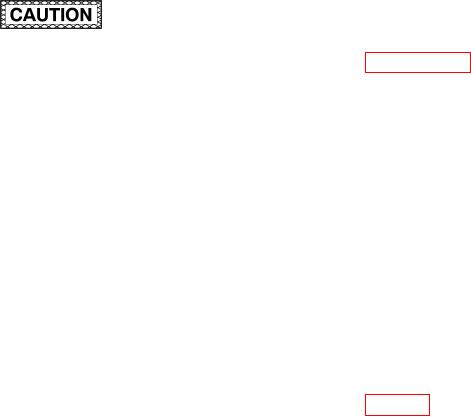
TM 1-1500-204-23-11
sealant overlap areas to ensure that no
blade in the utility knife to prevent tear-
gaps exist. Ensure there are 2 inches
ing the bagging ilm.
between the heater blanket and sealant
(r)
Connect the vacuum port to the vacuum
tape. Ensure enough room for the vac-
source using the vacuum hose.
uum port. If thermocouple wires or heat
blanket power cables contain outside
NOTE
insulation in addition to individual wire
insulation, the outside insulation must
The minimum permissible vacuum for com-
be removed to prevent vacuum leaks.
posite repairs is 20 inches Hg unless a lower
Remove 1 inch of outside insulation in
vacuum is speciied.
the area where wires interface with bag
sealant.
(s) Draw a full vacuum (>22 in Hg) on the
repair area. Smooth out wrinkles in the
(m) Lay a piece of breather material over the
vacuum bag as the vacuum is being
heater blanket. This should extend to
drawn down. If neither a caul plate nor
the sealant tape border and contact the
heat blanket is used, all wrinkles must
bleeder material.
be outside the patch area; any wrinkles
left over the patch area will be trans-
ferred to the patch.
(t)
Perform a vacuum integrity test per
Place vacuum port assembly at least 3 to 4
paragraph 6-18f and the system speciic
inches away from the repair area to prevent
technical manual. Ensure the minimum
wet epoxy resin from being drawn up into
vacuum level is achieved.
the port. Failure to do this could destroy the
port, vacuum hose assembly, and possibly
(u) Program the hot bonder with the cure
the vacuum pump.
proile from the system speciic tech-
nical manual or recommended by the
(n) Lay vacuum port base on breather
resin manufacturer per engineering dis-
material. Ensure the vacuum port base
position.
is not on top of the heat blanket. Use
one vacuum port for each 10 sq ft of
(v) Operate the hot bonder following the
vacuum bag.
manufacture s instruction manual.
(o) Lay vacuum bag ilm over the repair
(w) After the repair has cured, turn off the
area. This material should be large
power to the hot bonder and allow to
enough to overlap the sealant tape by at
cool before releasing the vacuum and
least one to two inches around the bor-
debagging the patch. Verify the cure
der of the repair area. If pleats are to be
temperature proile by reviewing the
used, place sealant tape directly on the
printout from the hot bonder.
bagging ilm at the location of the pleats.
(x) Inspect the repair patch according to
(p) Remove the backing paper from the
Chapter 5 and the system speciic tech-
sealant tape and press the vacuum bag
nical manual.
to the sealant tape. Start on one end
and carefully work your way around. Be
d. Envelope Bagging Procedure. Envelope bag-
careful not to introduce wrinkles into the
ging is a process in which the part to be repaired is
vacuum bagging ilm where it meets the
completely enclosed in a vacuum bag or the bag is
sealant tape as this will likely cause an
wrapped around the end of the component to obtain
air leak. To avoid wrinkles, sealant tape
an adequate seal. It is frequently used for removable
may be applied around the perimeter of
aircraft parts such as light controls, access panels,
the bagging ilm (in addition to the strip
etc., and when a part s geometry and/or the repair
on the component being repaired), the
location makes it very dificult to properly vacuum
backing tapes removed, and the sealant
bag and seal the area in a vacuum. In some cases,
tapes pressed against each other.
a part may be too small to allow for the installation
of a single-side bag whereas other times, the repair
(q) Connect the vacuum port top by cutting
is located on the end of a large component that
a small slit in the vacuum bag material
must have a vacuum bag wrapped around the ends
over the vacuum port base. Use a sharp
and sealed all the way around. In addition, some
6-56

